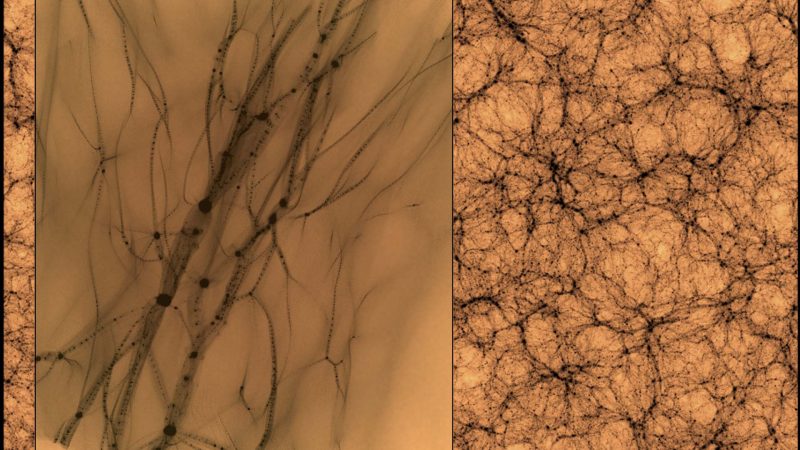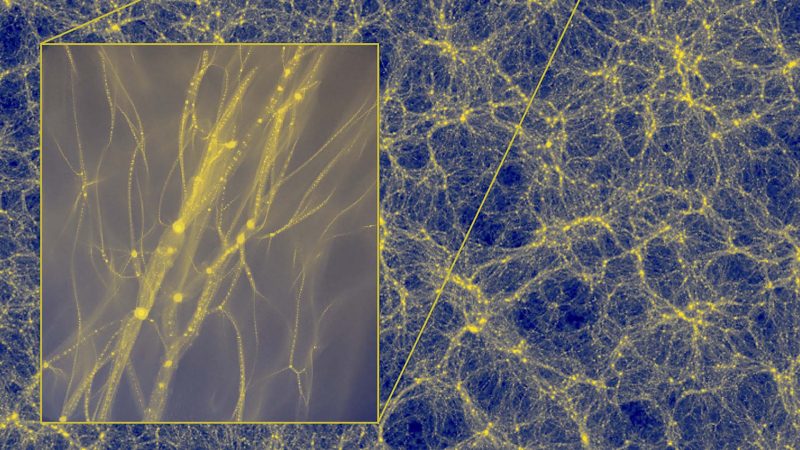

Zoomed-in, computer-generated simulation of the distribution of dark matter in the universe, also referred to as the cosmic web. The small, spherical blobs of dark matter that appeared scattered throughout the image are identified by scientists as dark matter haloes, gravitationally bound structures within which galaxies form. Image via J. Wang; S. Bose/ CfA.
Using the power of supercomputers, an international team of researchers has zoomed in on the smallest clumps of dark matter in a virtual universe. Published September 2, 2020 in the peer-reviewed journal Nature, the study reveals dark matter haloes as active regions of the sky, teeming with not only galaxies, but also radiation-emitting collisions that could make it possible to find these haloes in the real sky.
Dark matter – which makes up roughly 83% of the matter in the universe – is an important player in cosmic evolution, including in the formation of galaxies, which grew as gas cooled and condensed at the center of enormous clumps of dark matter. Over time, haloes formed as some dark matter clumps pulled away from the expansion of the universe due to their own enormous gravity. The largest dark matter haloes contain huge galaxy clusters – collections of hundreds of galaxies – and while their properties can be inferred by studying those galaxies within them, the smallest dark matter haloes, which typically lack even a single star, have remained a mystery until now.
Sownak Bose at CfA is one of the lead authors on the new research. He said:
Among the things we’ve learned from our simulations is that gravity leads to dark matter particles ‘clumping’ in overly dense regions of the universe, settling into what’s known as dark matter haloes. These can essentially be thought of as big wells of gravity filled with dark matter particles.
We think that every galaxy in the cosmos is surrounded by an extended distribution of dark matter, which outweighs the luminous material of the galaxy by between a factor of 10 to 100, depending on the type of galaxy. Because this dark matter surrounds every galaxy in all directions, we refer to it as a ‘halo.’

Sownak Bose is a postdoc at the Institute for Theory and Computation at the Harvard-Smithsonian Center for Astrophysics (CfA). He uses large numerical simulations to study the largest cosmological structures in our universe – what is called the cosmic web – and the evolution of galaxies. Image via CfA.
In the virtual universe simulated by these scientists, researchers were able to zoom in with the precision required to recognize a flea on the surface of the full moon – with magnification up to 10 to the power of seven, or 10 followed by seven zeroes – and create highly detailed images of hundreds of virtual dark matter haloes, from the largest known to the smallest expected. Bose explained:
Simulations are helpful because they help us quantify not just the overall distribution of dark matter in the universe, but also the detailed internal structure of these dark matter haloes. Establishing the abundance and the internal structure of the entire range of dark matter haloes that can be formed in the cold dark matter model is of interest because this enables us to calculate how easy it may be to detect dark matter in the real universe.
While studying the structure of the haloes via their simulation, researchers were met with a surprise: all dark matter haloes, whether large or small, have very similar internal structures which are dense at the center and become increasingly diffuse moving outward. Astronomer Jie Wang at the National Astronomical Observatories (NAOC) in Beijing, and lead author on the research, said:
Several previous studies suggested that the density profiles for super-mini haloes would be quite different from their massive counterparts. Our simulations show that they look similar across a huge mass range of dark haloes and that is really surprising.
Bose added that even in the smallest haloes which do not surround galaxies:
… Our simulations enabled us to visualize the so-called ‘cosmic web.’ Where filaments of dark matter intersect, one sees the tiny, near spherical blobs of dark matter, which are the haloes themselves, and they are so universal in structure that I could show you a picture of a galaxy cluster with a million billion times the mass of the sun, and an Earth-mass halo at a million times smaller than the sun, and you would not be able to tell which is which.

Astronomer Jie Wang of the National Astronomical Observatories in Beijing is lead author on the new research. Image via NOAC.
Although the images of dark matter haloes from this study are the result of simulations, the simulations themselves are informed by real observational data. For astronomers, that means the study could be replicated against the real night sky given the right technology. Bose said:
The initial conditions that went into our simulation are based on actual observational data from the cosmic microwave background radiation measurements of the Planck satellite, which tells us what the composition of the universe is and how much dark matter to put in.
During the study, researchers tested a feature of dark matter haloes that may make them easier to find in the real night sky: particle collisions. Current theory suggests that dark matter particles that collide near the center of haloes may explode in a violent burst of high-energy gamma radiation, potentially making the dark matter haloes detectable by gamma-ray and other telescopes. Bose said:
Exactly how the radiation would be detected depends on the precise properties of the dark matter particle. In the case of weakly interacting massive particles (WIMPs), which are among the leading candidates in the standard cold dark matter picture [currently the most popular theory among scientists to explain the nature of dark matter], gamma radiation is typically produced in the GeV [gigaelectronvolt] range. There have been claims of a galactic center excess of GeV-scale gamma radiation in the Fermi data, which could be due to dark matter or perhaps due to pulsars.
Wang added:
Ground-based telescopes like the Very Energetic Radiation Imaging Telescope Array System (VERITAS) can be used for this purpose, too. And, pointing telescopes at galaxies other than our own could also help, as this radiation should be produced in all dark matter haloes
With the knowledge from our simulation, we can evaluate many different tools to detect haloes – gamma-ray, gravitational lensing, dynamics. These methods are all promising in the work to shed light on the nature of dark matter particles.
The results of the study provide a pathway both for current and future researchers to better understand what’s out there, whether we can see it or not. Bose said:
Understanding the nature of dark matter is one of the Holy Grails of cosmology. While we know that it dominates the gravity of the universe, we know very little about its fundamental properties: how heavy an individual particle is, what sorts of interactions, if any, it has with ordinary matter, etc. Through computer simulations, we have come to learn about its fundamental role in the formation of the structure in our universe. In particular, we have come to realize that without dark matter, our universe would look nothing like the way it does now. There would be no galaxies, no stars, no planets, and therefore, no life.
This is because dark matter acts as the invisible skeletal structure that holds up the visible universe around us.

Zoomed in, computer-generated simulation of the distribution of dark matter in the universe, also referred to as the cosmic web. Inset: The highest level of magnification revealed tiny yellow blobs, or Earth-mass dark matter haloes as they would appear in the universe today. While they exist in the corresponding region of the background, they are visible only after zooming in several times. This is the first time these objects have ever been produced in a numerical simulation. Image via J. Wang/ S. Bose/ CfA.
Bottom line: Researchers in the U.S. and China used a supercomputer to probe dark matter haloes in a virtual universe. The work reveals dark matter haloes as active regions of the sky, teeming with not only galaxies, but also radiation-emitting collisions that could make it possible to find dark matter haloes in the real sky.
Source: Universal structure of dark matter haloes over a mass range of 20 orders of magnitude
from EarthSky https://ift.tt/2RosLrs


Zoomed-in, computer-generated simulation of the distribution of dark matter in the universe, also referred to as the cosmic web. The small, spherical blobs of dark matter that appeared scattered throughout the image are identified by scientists as dark matter haloes, gravitationally bound structures within which galaxies form. Image via J. Wang; S. Bose/ CfA.
Using the power of supercomputers, an international team of researchers has zoomed in on the smallest clumps of dark matter in a virtual universe. Published September 2, 2020 in the peer-reviewed journal Nature, the study reveals dark matter haloes as active regions of the sky, teeming with not only galaxies, but also radiation-emitting collisions that could make it possible to find these haloes in the real sky.
Dark matter – which makes up roughly 83% of the matter in the universe – is an important player in cosmic evolution, including in the formation of galaxies, which grew as gas cooled and condensed at the center of enormous clumps of dark matter. Over time, haloes formed as some dark matter clumps pulled away from the expansion of the universe due to their own enormous gravity. The largest dark matter haloes contain huge galaxy clusters – collections of hundreds of galaxies – and while their properties can be inferred by studying those galaxies within them, the smallest dark matter haloes, which typically lack even a single star, have remained a mystery until now.
Sownak Bose at CfA is one of the lead authors on the new research. He said:
Among the things we’ve learned from our simulations is that gravity leads to dark matter particles ‘clumping’ in overly dense regions of the universe, settling into what’s known as dark matter haloes. These can essentially be thought of as big wells of gravity filled with dark matter particles.
We think that every galaxy in the cosmos is surrounded by an extended distribution of dark matter, which outweighs the luminous material of the galaxy by between a factor of 10 to 100, depending on the type of galaxy. Because this dark matter surrounds every galaxy in all directions, we refer to it as a ‘halo.’

Sownak Bose is a postdoc at the Institute for Theory and Computation at the Harvard-Smithsonian Center for Astrophysics (CfA). He uses large numerical simulations to study the largest cosmological structures in our universe – what is called the cosmic web – and the evolution of galaxies. Image via CfA.
In the virtual universe simulated by these scientists, researchers were able to zoom in with the precision required to recognize a flea on the surface of the full moon – with magnification up to 10 to the power of seven, or 10 followed by seven zeroes – and create highly detailed images of hundreds of virtual dark matter haloes, from the largest known to the smallest expected. Bose explained:
Simulations are helpful because they help us quantify not just the overall distribution of dark matter in the universe, but also the detailed internal structure of these dark matter haloes. Establishing the abundance and the internal structure of the entire range of dark matter haloes that can be formed in the cold dark matter model is of interest because this enables us to calculate how easy it may be to detect dark matter in the real universe.
While studying the structure of the haloes via their simulation, researchers were met with a surprise: all dark matter haloes, whether large or small, have very similar internal structures which are dense at the center and become increasingly diffuse moving outward. Astronomer Jie Wang at the National Astronomical Observatories (NAOC) in Beijing, and lead author on the research, said:
Several previous studies suggested that the density profiles for super-mini haloes would be quite different from their massive counterparts. Our simulations show that they look similar across a huge mass range of dark haloes and that is really surprising.
Bose added that even in the smallest haloes which do not surround galaxies:
… Our simulations enabled us to visualize the so-called ‘cosmic web.’ Where filaments of dark matter intersect, one sees the tiny, near spherical blobs of dark matter, which are the haloes themselves, and they are so universal in structure that I could show you a picture of a galaxy cluster with a million billion times the mass of the sun, and an Earth-mass halo at a million times smaller than the sun, and you would not be able to tell which is which.

Astronomer Jie Wang of the National Astronomical Observatories in Beijing is lead author on the new research. Image via NOAC.
Although the images of dark matter haloes from this study are the result of simulations, the simulations themselves are informed by real observational data. For astronomers, that means the study could be replicated against the real night sky given the right technology. Bose said:
The initial conditions that went into our simulation are based on actual observational data from the cosmic microwave background radiation measurements of the Planck satellite, which tells us what the composition of the universe is and how much dark matter to put in.
During the study, researchers tested a feature of dark matter haloes that may make them easier to find in the real night sky: particle collisions. Current theory suggests that dark matter particles that collide near the center of haloes may explode in a violent burst of high-energy gamma radiation, potentially making the dark matter haloes detectable by gamma-ray and other telescopes. Bose said:
Exactly how the radiation would be detected depends on the precise properties of the dark matter particle. In the case of weakly interacting massive particles (WIMPs), which are among the leading candidates in the standard cold dark matter picture [currently the most popular theory among scientists to explain the nature of dark matter], gamma radiation is typically produced in the GeV [gigaelectronvolt] range. There have been claims of a galactic center excess of GeV-scale gamma radiation in the Fermi data, which could be due to dark matter or perhaps due to pulsars.
Wang added:
Ground-based telescopes like the Very Energetic Radiation Imaging Telescope Array System (VERITAS) can be used for this purpose, too. And, pointing telescopes at galaxies other than our own could also help, as this radiation should be produced in all dark matter haloes
With the knowledge from our simulation, we can evaluate many different tools to detect haloes – gamma-ray, gravitational lensing, dynamics. These methods are all promising in the work to shed light on the nature of dark matter particles.
The results of the study provide a pathway both for current and future researchers to better understand what’s out there, whether we can see it or not. Bose said:
Understanding the nature of dark matter is one of the Holy Grails of cosmology. While we know that it dominates the gravity of the universe, we know very little about its fundamental properties: how heavy an individual particle is, what sorts of interactions, if any, it has with ordinary matter, etc. Through computer simulations, we have come to learn about its fundamental role in the formation of the structure in our universe. In particular, we have come to realize that without dark matter, our universe would look nothing like the way it does now. There would be no galaxies, no stars, no planets, and therefore, no life.
This is because dark matter acts as the invisible skeletal structure that holds up the visible universe around us.

Zoomed in, computer-generated simulation of the distribution of dark matter in the universe, also referred to as the cosmic web. Inset: The highest level of magnification revealed tiny yellow blobs, or Earth-mass dark matter haloes as they would appear in the universe today. While they exist in the corresponding region of the background, they are visible only after zooming in several times. This is the first time these objects have ever been produced in a numerical simulation. Image via J. Wang/ S. Bose/ CfA.
Bottom line: Researchers in the U.S. and China used a supercomputer to probe dark matter haloes in a virtual universe. The work reveals dark matter haloes as active regions of the sky, teeming with not only galaxies, but also radiation-emitting collisions that could make it possible to find dark matter haloes in the real sky.
Source: Universal structure of dark matter haloes over a mass range of 20 orders of magnitude
from EarthSky https://ift.tt/2RosLrs

Aucun commentaire:
Enregistrer un commentaire